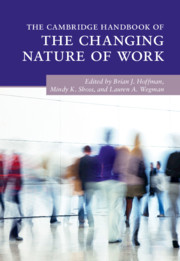Book contents
- The Cambridge Handbook of the Changing Nature of Work
- The Cambridge Handbook of the Changing Nature of Work
- Copyright page
- Contents
- Figures
- Tables
- Contributors
- Part I Introduction to the Changing Nature of Work
- Part II What Has Changed?
- Part III Implications for Talent Management and Impact on Employees
- 14 Implications of the Changing Nature of Work for Selection
- 15 Implications of the Changing Nature of Work for Recruitment and Retention
- 16 Performance Management and the Changing Nature of Work
- 17 Implications of the Changing Nature of Work for Training
- 18 Leader Behaviors and the Changing Nature of Work
- 19 The Changing Nature of Teams
- 20 Managing Employees across the Working Lifespan
- 21 Implications of the Changing Nature of Work for Employee Attitudes and Work Perceptions
- 22 Implications of the Changing Nature of Work for the Interface between Work and Nonwork Roles
- 23 Implications of the Changing Nature of Work for Employee Health and Safety
- 24 The Dark Side of Workplace Technology
- 25 Implications of the Changing Nature of Work for the Employee–Organization Relationship
- 26 The Future of Work
- 27 Sustainability as a Driver of Organizational Change
- Index
- References
23 - Implications of the Changing Nature of Work for Employee Health and Safety
from Part III - Implications for Talent Management and Impact on Employees
Published online by Cambridge University Press: 02 April 2020
- The Cambridge Handbook of the Changing Nature of Work
- The Cambridge Handbook of the Changing Nature of Work
- Copyright page
- Contents
- Figures
- Tables
- Contributors
- Part I Introduction to the Changing Nature of Work
- Part II What Has Changed?
- Part III Implications for Talent Management and Impact on Employees
- 14 Implications of the Changing Nature of Work for Selection
- 15 Implications of the Changing Nature of Work for Recruitment and Retention
- 16 Performance Management and the Changing Nature of Work
- 17 Implications of the Changing Nature of Work for Training
- 18 Leader Behaviors and the Changing Nature of Work
- 19 The Changing Nature of Teams
- 20 Managing Employees across the Working Lifespan
- 21 Implications of the Changing Nature of Work for Employee Attitudes and Work Perceptions
- 22 Implications of the Changing Nature of Work for the Interface between Work and Nonwork Roles
- 23 Implications of the Changing Nature of Work for Employee Health and Safety
- 24 The Dark Side of Workplace Technology
- 25 Implications of the Changing Nature of Work for the Employee–Organization Relationship
- 26 The Future of Work
- 27 Sustainability as a Driver of Organizational Change
- Index
- References
Summary
Work is among the most important influences on safety, health and wellbeing, both as a threat to health and as a source of resources that support health. However, the nature and pace of changes to the modern workplace present significant challenges to researchers seeking to understand the health implications of these changes, as well as to government and organizational leaders seeking to craft appropriate policy solutions. This chapter has three goals: (1) to provide an overview of occupational health psychology and describe the NIOSH concept of work organization in terms of implications for occupational health, (2) to present the Job Demands–Resources model as a theoretical framework accounting for the effects of work organization on employee health, and (3) describe health implications of several key trends in the nature of work organization including the employment relationships, work schedules, technology, lean production, and safety and wellness interventions.
Keywords
- Type
- Chapter
- Information
- The Cambridge Handbook of the Changing Nature of Work , pp. 489 - 508Publisher: Cambridge University PressPrint publication year: 2020
References
- 1
- Cited by



